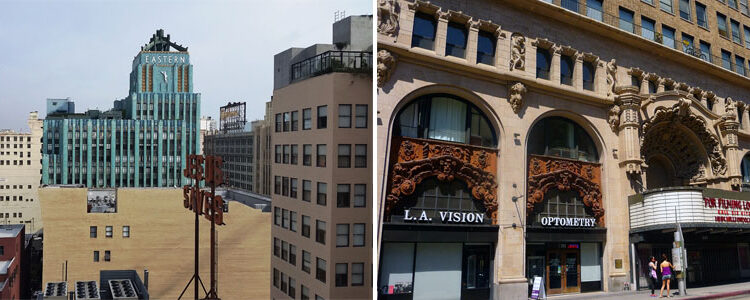
Downtown Design Guide
What is the Downtown Design Guide?
Adopted in 2009, the Downtown Design Guide outlines standards (requirements) and guidelines (suggestions) for proposed new construction projects in downtown Los Angeles. It does not apply to adaptive reuse or rehabilitation projects, as those must conform to the Adaptive Reuse Ordinance and/or the Secretary of the Interior's Standards for Rehabilitation.
What does the Downtown Design Guide mean for me?
The Guide is intended to encourage a livable downtown that balances preservation and new construction while promoting:
- A diveristy of housing choices and employment opportunities
- A rich cultural and civic environment
- Safe, shared streets featuring a range of transportation options and pedestrian-friendly services
- Active gathering places and recreation areas
The underlying philosophy of the Guide is that urban neighborhoods thrive when they feature buildings of mixed age and typology, as well as a range of uses. The key challenge with the Guide, however, is that it never anticipated the intensity of new development that currently characterizes downtown neighborhoods.
Background
In 2009, City Council adopted the Downtown Design Guide. The pioneering document was the culmination of a multi-year effort to develop clear guidelines for sensitive new construction and historic preservation in downtown.
The Conservancy played a key role in the preparation of the Downtown Design Guide, having commissioned the original Historic Downtown Los Angeles Design Guidelines in 2002. This document was the foundation of both the Downtown Design Guide and the 2009 Broadway Theater and Entertainment District Guide.
The Downtown Design Guide aims to promote the creation of a more livable and sustainable downtown, including active open spaces, a diversity of housing and transportation options, vibrant streetscapes, and neighborhood-serving uses.
It applies to the following downtown neighborhoods: Civic Center, Civic Center South, Little Tokyo, Bunker Hill, Financial Core, Historic Downtown (or the Historic Core), City Market, South Park, and the Convention Center.
At its core, the Guide seeks to reinforce and enhance the unique historic character of downtown neighborhoods while encouraging compatible, yet innovative new design. The document specifically states that new construction should "respect historically significant districts and buildings, including massing and scale, and neighborhood context."
In concert with the Broadway Theater and Entertainment District Guide, these standards and guidelines underscore the desire for a coehsive and walkable pedestrian environment in downtown Los Angeles, especially in the Historic Core.
Since the adoption of both guides, downtown Los Angeles has witnessed a development boom, bringing new residents, workers, and thrill seekers to the city's center. The neighborhood's current rate of change far outpaces what the Downtown Design Guide anticipated.
Though much of this development is concentrated in the South Park area, high rise projects such as The Alexan Project (located at 9th and Hill), the Spring Street Hotel (631-635 S. Spring Street), and the Equity Residential Mixed-Use Project (located at 4th and Hill) are increasingly proposed for lots in and around the Historic Core. These developments are introducing a new scale and massing to the historic neighborhood, as well as contemporary materials and design features, such as balconies, that alter the character of the community.
Today, the City is in the early stages of updating the Central City Community Plan as a key means of managing change in downtown. Updates to the existing Downtown Design Guide, as a key part of the Community Plan process, could further reinforce the existing character of the Historic Core while encouraging high rise development in more appropriate locations.